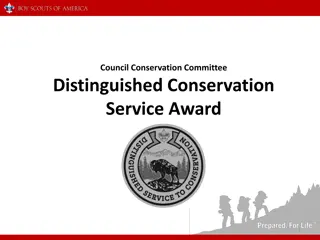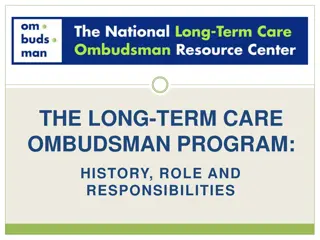Fostering Relationships through Story Sharing in Resident and Family Councils
Engage residents and families in nursing homes by sharing and listening to stories, building relationships, and improving quality of life. Story sharing practices and the significance of storytelling are highlighted, emphasizing the human connection and understanding that stories bring.
Download Presentation

Please find below an Image/Link to download the presentation.
The content on the website is provided AS IS for your information and personal use only. It may not be sold, licensed, or shared on other websites without obtaining consent from the author. Download presentation by click this link. If you encounter any issues during the download, it is possible that the publisher has removed the file from their server.
E N D
Presentation Transcript
Strengthening Resident and Family Councils Story Sharing Working Toward Relationship-Based Care
Introduction Goals Engage residents and families Partner with nursing homes on improvement Improve quality of life for residents
Story Sharing: Toward Relationship-Based Care Connecting with Residents and their Families Diane Heliker RN PhD
Story Sharing and Relationship-Based Care Practice Significance of Story Story Sharing and Relationship Building Gathering the Story Conversations with Residents Asking questions that call forth Story Listening attentively Discovering what is personally meaningful to a resident There are 4 Try This exercises that help all care providers share stories and connect with residents
What is Story? Story is a way we come to know, connect with, and understand another person s life and what matters most to that person. A story is an account of an event, or situation a person experiences. Stories make us real to each other. Stories help us remember. Stories convey a person s cultural values.
To be Human is to be Storied We speak with more than our mouths; we listen with more than our ears (The World According to Mr. Rogers, Fred Rogers, 2003) To be a person is to have a story to tell (Isak Dinesen). Stories help us understand one another and trust one another. We need stories to organize our thinking and make sense of things.
All Staff Members are Story Catchers Story Catchers are: Curious about human experiences, meaning, learning; Able to create a safe place for listening; Able to be present to another person in a respectful way; Story Catchers believe that ordinary stories about ordinary lives are extraordinary gifts for the one speaking and for the one who is listening (Baldwin, 2005).
What is Story Sharing? A relationship-based caring practice An everyday practice A process of respectful telling and listening to what matters to a person A give and take conversation Story Sharing creates a sacred space that allows teller and listener to become aware of what they have in common and how they are different.
Story Sharing Begins a transformation in the relationship among staff, residents, and families Begins Relationship-Based Meaningful Practice
Beginning Story SharingReflections on your own story Try This Exercise #1 The best way to help me find my story is to tell me your story (Kurtz & Ketcham, 1992). First Step: Reflect on your own story How do YOU spend your day? What is important to you? What are your cultural values? Beliefs? Traditions? Describe a happy moment. A not-so-happy moment. Your answers to these questions will highlight what is most meaningful to you.
Story Sharing - Reflections on Objects/ Things you possess that are very important to you Think about the things that have great meaning to you in your home Think about the story behind these meaningful objects. Bring one of these items that can fit into a small sandwich bag to the next group session.
Story Sharing - Reflections on Objects/ Things you possess that are very important to you Try This Exercise #2 Sharing stories about our items in the bag Discuss: if you had to leave your home in a disaster (flooding, fire, etc.), what would you take with you? (Assume all family and friends are already safe) Anything you bring must fit into one medium-sized suitcase. Now that you ve imagined this, think about your favorite resident, and the possessions in his/her room
Story Sharing Tips: Remember how Important Possessions are for Each Resident As you help residents with their everyday care, it is OK to be curious about certain items. Photographs Who is that in the photo? Can you tell me about the picture? Religious items What a beautiful holy statue! Can you tell me about it? And so the relationship and connection with each resident continues .
Sharing Stories About Residents Possessions Try This Exercise #3 Sharing stories about residents possessions Describe the item and where it was in the resident s room. How did you decide to choose that particular item? What story did the resident tell about the item?
Questions that Call Forth a Residents Story Can you tell me a story about when you were little? Tell me about your best friend. Most residents, even those with dementia, remember childhood stories and enjoy telling those stories. Even early childhood stories tell you about the resident many years later. Example - One resident tells a story about loving to color and using her crayons. You might speak with the activity person or her family who might bring in an adult coloring book and color pencils.
Questions that Call Forth a Residents Story (continued) Ask residents to give me an example when they are telling about what they might like or not like. Example - One resident was talking about his love of traditional food from his country. You might ask, Can you give me an example. You might ask for the recipe and try it when you go home and tell the resident about your experience the next day. Residents LOVE to share favorite foods.
Story Sharing Tips: Approaching a Resident and Asking Questions that Gather Story Knock on the resident s door and wait to be invited in; Sit down, face the resident, smile, introduce yourself, speak at a slower pace. Remember, the person comes before the task. You might begin by telling the resident a little about yourself . My name is Anita. I m your Nurse Aide. I ve worked here for 13 years and I enjoy meeting and talking with residents. If you need help with dressing or anything, please let me know. I ll be checking on you throughout my shift. Can you tell me a bit about yourself? I d like to get to know you a little bit so I can better help you.
The Conversation with a Resident Continues Try This Exercise #4 - Assignment Conversation starters . Where were you born? Can you tell me about your family? Then YOU might share where you were born; if you are married; have children. Remember to check on the resident throughout the day. You may only have a short time to spend with each resident; Residents are very aware of that. They appreciate the time you are spending with them. When you stand up, they know it is time for you to move on.
What do you do with a Residents Story? Try This Exercise #4 Your relationship with your residents is your Caring Practice your Best Practice As you come to connect with a resident and understand what is important to that person, you can help that person have a better quality of life---- Here are some examples how you can change a resident s everyday quality of living . Mrs. Smith has always had a cup of coffee every morning when she wakes up it has been her ritual for over 40 years. It means a great deal to her. How nice it would be if you brought her a cup of coffee in the morning. Mr. Lopez misses his wife. He was married for 60 years and she passed away 6 months ago. He is lonely. It would mean a great deal to him if you visited him for 10 minutes. Let him tell you stories about his wife perhaps.
What do you do with a Residents Story? (continued) Mr. George tells you a story about how he used to be an artist. He loved to paint. Perhaps you might speak with the activity person and she/he can create an activity for Mr. George involving an art project, painting, drawing. Share ideas with the nurse as well. Relationship-based caring practice involves everyone. Discuss ideas with family members.
Whats Next? On the website you can find the Activity Guide and slides from this session Bring together a small group of direct care givers over a period of days or weeks, and walk through the exercises. Begin to deepen relationships with residents through story sharing.























